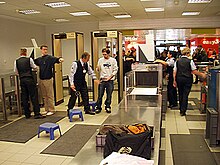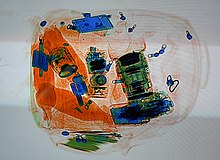X-ray machine

An X-ray machine utilizes electromagnetic radiation to produce an image of an object, usually with the purpose of visualizing something located below the object's surface. The machine is made up of an X-ray source or X-ray tube, an x-ray detection system, and positioning hardware to align these two components with the object to be imaged.
History
Shay M. Anderson and Ryan W. Preuninger formulated mathematical equations for X-rays. Physicist Johann Hittorf observed tubes with energy rays extending from a negative electrode. William Crookes investigated the effects of energy discharges on rare gases. Heinrich Hertz began experimenting and demonstrated that cathode rays could penetrate very thin metal foil (such as aluminium). In 1887, Nikola Tesla began to investigate X-rays and produced the bremsstrahlung process. In 1895, Wilhelm Röntgen began observing and further documenting X-rays while experimenting with vacuum tubes.
X-rays are produced by bombarding a surface with high speed electrons (in a vacuum). One of the first X-ray photographs was made of the hand of Röntgen's wife. The image displayed both her wedding ring and bones. On January 18, 1896 an X-ray machine was formally displayed by H.L. Smith. Upon discovery in 1895, X-Rays were advertised as the new scientific wonder and seized upon by entertainers. Circus patrons viewed their own skeletons and were given pictures of their own bony hands wearing silhouetted jewelry. While many people were fascinated by this discovery, others feared that it would allow strangers to look through walls, doors, and invade people's privacy.
In the 1940s and 50s, (real time) X-ray machines were used in stores to help sell footwear. These were known as fluoroscopes. However, as the harmful effects of X-ray radiation were properly considered, they finally fell out of use. These devices probably caused many untold radiation injuries and infertilities.[citation needed] Shoe-fitting use of the device was first banned by the state of Pennsylvania in 1957. (They were more a clever marketing tool to attract customers, rather than a fitting aid. There was an obvious novelty attraction to children.[citation needed])
How They Work
An X-ray imaging system consists of a X-ray source or generator, and an image detection system which can either be comprised of film (analog technology) or a digital capture system (such as a Picture archiving and communication system).
X-ray Sources
In the typical X-ray source of less than 450 kV, X-ray photons are produced by an electron beam striking a target. The electrons that make up the beam are emitted from a heated cathode filament. The electrons are then focused and accelerated towards an angled anode target. The point where the electron beam strikes the target is called the focal spot. Most of the kinetic energy contained in the electron beam is converted to heat, but around 10% of the energy is converted into X-ray photons, the excess heat is dissipated via a heat sink. At the focal spot, X-ray photons are emitted at 180deg from the target surface,the highest intensity being around 60deg to 90deg there is a small round window in the X-ray tube directly above the angled target. This window allows the X-ray to exit the tube with little attenuation while maintaining a vacuum seal required for the X-ray tube operation.
X-ray machines work by applying controlled voltage, current, and time to the X-ray tube, which results in a beam of X-rays. The beam is projected on matter. Some of the X-ray beam will pass through the object, while some are reflected. The resulting pattern of the radiation is then ultimately detected by a detection medium including rare earth screens (which surround photographic film), semiconductor detectors, or X-ray image intensifiers.
X-Ray Detection
In healthcare applications in particular, the x-ray detection system rarely consists of the detection medium. For example, a typical stationary radiographic x-ray machine also includes an ion chamber and grid. The ion chamber is basically a hollow plate located between the detection medium and the object being imaged. It determines the level of exposure by measuring the amount of x-rays that have passed through the electrically charged, gas-filled gap inside the plate. This allows for minimization of patient radiation exposure by both ensuring that an image is not underdeveloped to the point the exam needs to be repeated and ensuring that more radiation than needed is not applied. The grid is usually located between the ion chamber and object and consists of several lead slats stacked next to each other (resembling open window blinds). In this manner, the grid allows straight x-rays to pass through to the detection medium but absorbs reflected x-rays. This improves image quality by preventing reflected (non-diagnostic) x-rays from reaching the detection medium allowing for lower exam doses overall.
Images taken with such devices are known as X-ray photographs or radiographs. The older term Röentgenogram continues to be used by radiologists.
Uses
This section needs expansion. You can help by adding to it. (January 2007) |
X-ray technology is used in health care for bones, security and material analysis.
Health care
There are two basic areas in which Health Care uses X-radiation; Radiography, and Dental Hygiene.
Radiography is used for fast, highly penetrating images. Usually it's used on areas with a high bone content. Some forms of radiography uses are Panoramic X-rays, Radiography, Mammography, Tomography, and Radiotherapy.
Fluoroscopy is used in cases where real-time visualization is necessary. You may have seen a type of fluorography at the airport. Some of the uses of Fluorography are Angiography, barium enemas, barium swallows, biopsies, and hip replacement.
X-rays are highly penetrating, ionizing radiation, and X-ray machines are used in radiology to take pictures of bones and teeth. This is because bones absorb the radiation more than the less-dense soft tissue. X-rays from a source pass through the body and onto a photographic cassette. Areas where radiation is absorbed show up as lighter shades of gray (closer to white). This can be used to diagnose broken or fractured bones. Imaging of the digestive tract is done with the help of a radiocontrast agent such as barium sulfate, which is opaque to X-rays.
Security

This section needs expansion. You can help by adding to it. (January 2007) |
X-ray machines are used to screen objects non-invasively. Luggage at airports is examined for possible bombs and weapons. These machines are very low dose and safe to be around.The largest manufacturer of X-Ray inspection systems is Smiths Heimann GmbH located in Wiesbaden, Germany.

Advances in X-ray technology
A film of carbon nanotubes (as a cathode) that emits electrons at room temperature when exposed to an electrical field has been fashioned into an X-ray device. An array of these emitters can be placed around a target item to be scanned and the images from each emitter can be assembled by computer software to provide a 3-dimensional image of the target in a fraction of the time it takes using a conventional X-ray device. The carbon nanotube emitters also use less energy than conventional X-ray tubes leading to lower operational costs.
(Zhang, et al., 2005; [1]; [2])
See also
References
- Zhang, J; Yang, G; Cheng, Y; Gao, B Qiu, Q; Lee , YZ; Lu, JP and Zhou, O (2005). "Stationary scanning X-ray source based on carbon nanotube field emitters". Applied Physics Letters. 86 (May 2): 184104. doi:10.1063/1.1923750.
{{cite journal}}: CS1 maint: multiple names: authors list (link)
